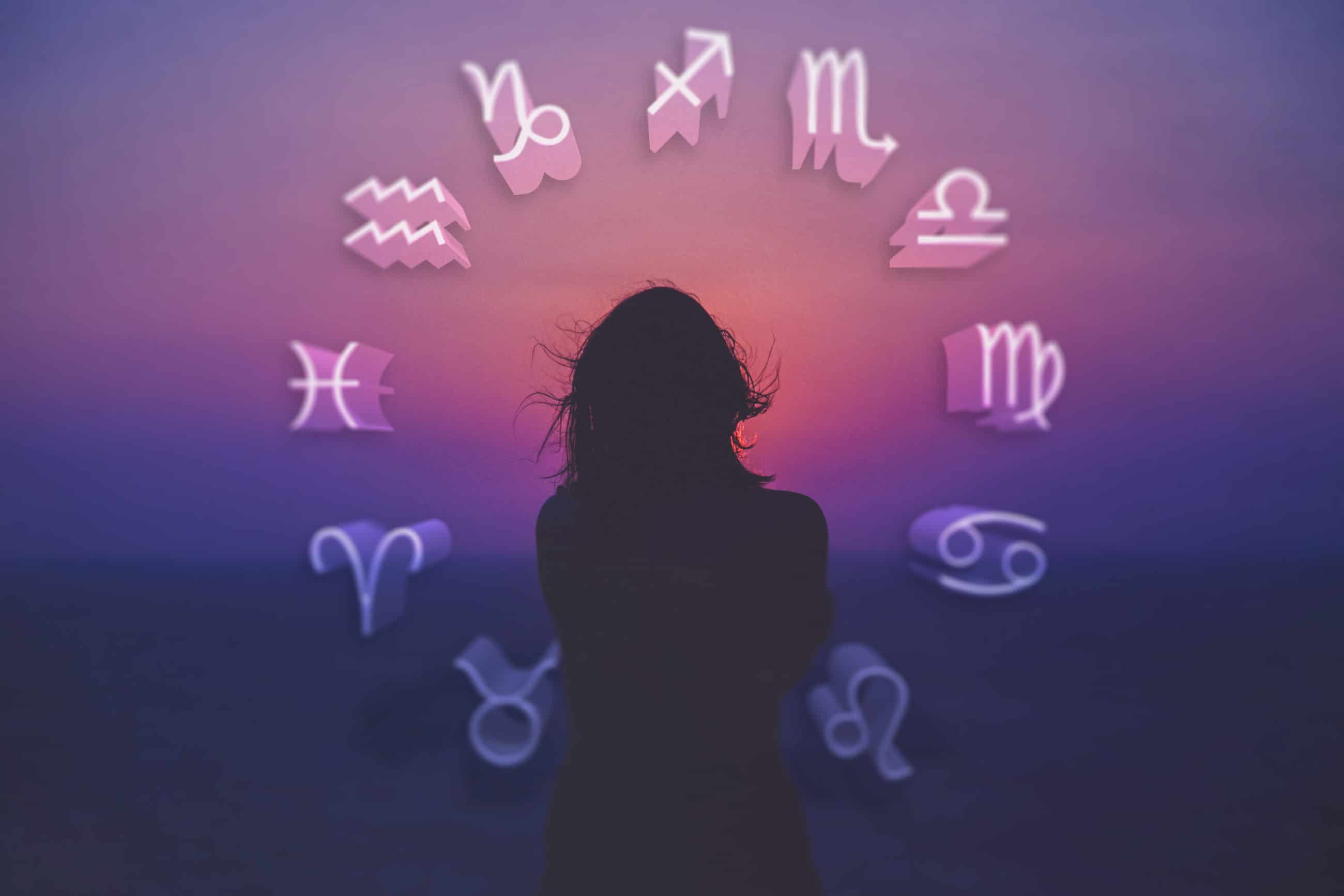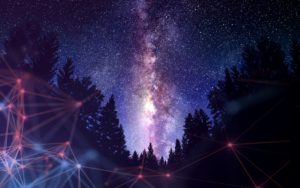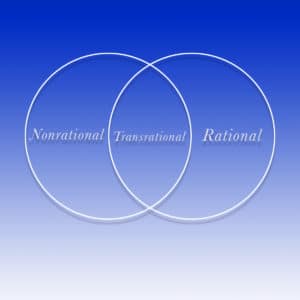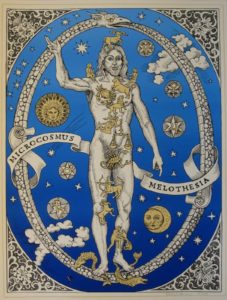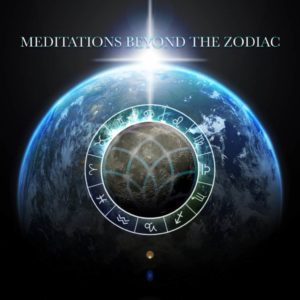Today’s cultural thought-space, or noosphere, is filled with the thought system of rationality.
Artifacts of humanity’s earlier world views are seen as outmoded, pre-rational superstitions. The tribal, animistic beliefs and practices of ancient cultures have been replaced by reason and science. There are no Gods seeking vindication for our slights, illnesses are not caused by demons and curses but by pathogens, genetic predispositions and biophysical processes. And the superstitions of the past are understood to be merely the result of our lack of knowledge coupled with our wild imaginations.
The scientific method, it seems to many of us, provides us with all the answers we could ever need. But there are mysteries the scientific method has not been able to fully illuminate.
Psychology has been around for over 100 years and society is arguably more mentally unhealthy than ever. Our social space is fraught with values-conflicts, destructive competition, and exploitation. The suicide rate is higher than it’s ever been. According to the World Health Organization, one million people commit suicide each year worldwide. That is about one death every 40 seconds or 3,000 per day. And for each individual who takes his/her own life, at least 20 attempt to do so. Suffering and the causes of suffering have not been fully understood or properly addressed. The human condition, and all its depth and complexity is not mastered by empiricism alone. Rationality and the methods of analytical reductionism – how science investigates – have failed to deliver humanity to the kind of solace we once imagined it would. With all the benefits science has provided, it hasn’t been able to answer the most important of all questions: Why are we here? What is the nature of consciousness? What is the purpose or meaning of existence? And, given the most comprehensive answers to these questions, will we be more healthy?
While materialism seems to offer what faith has been lacking for centuries, correcting many of its deficiencies, it is unable to provide all the ingredients to reconcile the chaos that lurks in the primordial unknown or its expression through the human psyche.
We are as confused about the nature of the mind and being as we ever have been. Yes, we understand the physical mechanisms of our world better than we have so far, but none of that knowledge has liberated us from the uncertainty and fear at the very depths of our being.
As we made this monumental leap into the materialistic worldview, we dismissed the non-rational, and we have categorically dismissed the numinous, the supernal, the symbolic and ritualistic dimensions of the human experience as irrelevant or even pathological.
There’s no doubt that the intellectual artifacts of antiquity have been fraught with problems. Our false beliefs have created their own kinds of tyranny. Countless atrocities have been born out of the pre-rational fallacies of superstition. But in many of them, there is a baby in the bathwater. We need to learn to sort out the false from the true and the useful from the useless. Like sorting out the wheat from the chaff, we need to better learn how to process out the nourishing substances from the toxic, both ancient and modern.
We want answers to our deepest questions, and we’re unsatisfied with mere beliefs. We want answers that are verifiable to our modern evidence procedures. But unless we include and transcend our rationality we won’t access the capacity to apprehend the ineffable and its most elusive gem: Meaning.
How can we include the merits of both the rational view and the prerational view in a new worldview?
We are meaning-making beings with souls who partake not just of the material and rational kinds of sense making, but of the ineffable, the symbolic and the poetic domains of thought and imagination. The soul listens to the music of life. We don’t merely interpret the cosmos through the language of science. A part of us is moved, vivified and enlivened by the essence of beauty and the poetry of the felt sense of meaning.
Astrology is one of the oldest intellectual pursuits of the human mind, having existed almost as long as language and writing. Though we now have physics, astronomy, and chemistry, astrology is still valued by much of the world’s population as offering something of value to the quest for self knowledge. Great thinkers like Joseph Campbell and Carl Jung have offered us insights into the value of mythology. They have revealed to us that the depth of the human psyche and the nature of the human experience is not reducible to mere mechanical objects and processes.
The starry vault of heaven is in truth the open book of cosmic projection, in which are reflected the mythologems, i.e., the archetypes. In this vision astrology and alchemy, the two classical functionaries of the psychology of the collective unconscious, join hands. – Carl .G. Jung
Those whose intelligence has revealed to them the native dialect of understanding have created a field of psychology called trans-personal psychology. This field studies the realms of human experience and evolution that go beyond the boundaries of analytical reductionism, attempting to secure for us the right to honor the ineffable meaning-making processes of thought and symbol. They have discovered that our evolution leads us from the pre-rational to the rational and to the trans-rational, where our sense making surpasses the limits of our logical and linear processes.
While the archaic practices of divination, magic spells and the rituals of supplication may have expressions that are enacted through a pre-rational lens, our rational world view fails to provide a sufficient means to address the authentic need of the human spirit to feel and know that there is a purpose to life itself. Reason without the appreciation and inclusion of the pre-modern modes of sense making leaves us without a full spectrum approach to the greatest of all mysteries.
Horoscopes are in most cases rooted in a kind of low-resolution approach to astrology which can be a distraction. Yet an archetypal wisdom still sleeps within astrology’s superficial facade awaiting our deep inquiry.
But to excavate wisdom from its symbols and narratives is no simple undertaking, even when we suspect that gems may lie within its grimy husks.
What differentiates pre-rational superstition from trans-personal psychology? What distinguishes the pre-personal from the trans-personal, or gnosis from mere belief? It is these questions that mark the beginning of a right orientation to the boundaries of the known.
Thomas Aquinus, a prominent theologian, scholar and Christian mystic once said something like, (paraphrased) “For those that know, no explanation is needed, but for those that don’t know, no explanation will suffice.” The transpersonal is so elusive, hiding its secrets in a world of symbols and metaphors that we need a faculty indigenous to its domain to apprehend it. Like a vaporous ether drifting away from our approach, our attempts at grasping at it with our faculties of reason alone causes it to slip through the fingers, distorting and dissipating its gossamer forms.
Or like the 9 headed hydra that Hercules faced in his quest, when we swing hap-hazardly at this great creature with our sword of discernment lopping off one of its heads, two grow back in its place. For every paradox, every supernal reality we attempt to reconcile with the concretizing blows of labels and names, we merely bifurcate it further, confounding our minds with dualities. We must find a new means of approach to the ageless quest for gnosis.
It has been said that the numinous cannot be taught, but it can be learned. How then do we grow in our capacities to apprehend the ineffable? How do we thread the camel of our thinking through the eye of a needle, approaching the mystery of being in a way that doesn’t distort its forms and hues?
One method is through the indigenous language of the pre-verbal mind, the language of myth and symbol that the unconscious mind speaks fluently. The 12 signs of the Zodiac, despite its often absurd or benign appearance, is a symbolic narrative telling the perennial tale of creation and the heroic ascent of man through the grades of evolution. The greatest of all mysteries veiled in the reified shrouds of thought and learned knowledge is not impenetrable. It can be encountered in the organs of perception yet unawakened.
To apprehend the ineffable we must awaken within us a new skill, one that has at its disposal all the assets of reason, but also has the assets of our earlier means of sense-making.
Astrology is an esoteric technology, but like an ice-berg whose mass is largely hidden beneath the surface of the ocean, we must dive beneath the membrane at the horizon to discover its full significance.
In Aries we see the motive force of initiation, the vitality that brings into being something altogether novel. The heroism and thirst for adventure in the pioneering spirit of the human heart brings light and order to the edges of the chaotic unknown.
In Leo we find our declarations of sovereignty, autonomy, resilience and the radiance of our intention for truth, beauty and goodness. Its passion seeks to guide all things toward their flowering and fruiting for the sake of love.
In Sagittarius we see the upward gaze of our highest ideations. Our optimism, our visionary yearnings for the broadest and deepest expression of goodness we can imagine.
Together each of these indwelling patterns makes up the properties of fire as it lives in the human spirit. Like the flame, with its properties of combustion, radiance of light, and its upward movement, Aries, Leo and Sagittarius are the three properties of fire as lived in the human experience. Each of these properties live and have their being in every human. And when these properties are concentrated in an individual’s Sun or rising sign we think of them as being of that sign.
And, like the 12 tribes of Israel, the 12 apostles of Jesus, the 12 labors of Hercules, and the 12 Olympian deities, the 12 signs of the zodiac are the mythopoetic expression of the sum total of human characteristics. And, these inner lights of our psycho-spiritual nature are not just in our heads. They are embodied in the heavens, in the constellations above our heads, embodying the ageless axiom that says, “That which is above is as that which is below”, reminding us that the microcosm of our inner architecture and the macrocosm of the universe are but one thing, expressed in another manner, at different scales and domains of manifestation.
From this orientation to the nature of nature, we are given a cue to navigate the heavens, both inner and outer. As we explore this frontier and begin to illuminate the full depth and breadth of meaning above and below our conscious understanding, we walk the path of creation and ascension. In this way we develop a truly comprehensive way of making meaning about the nature of nature, discovering that we ourselves are among its branches. And, through the right use of its symbols we can more skillfully bring about the flowering of consciousness and its many gifts.
Trans-personal hypnosis is perhaps one of the best means of diving beneath the surface. Using trance and metaphor to awaken our latent sense making capabilities provides us the means to approach this great mystery. In a series of trans-personal meditations that explore the archetypes of the Zodiac, I invite people to dive beneath the surface of the mind. In this series we attempt to actualize the values and latent capacities intimated by the Astrological metaphors. In this way, we navigate our awareness beyond the reifying tendency of belief and learned knowledge, neither accepting or rejecting Astrology at its face value, but rather leaning into its ephemeral poetry, exploring its essence through the heart and its felt sense.
This experiment, we may come to find, doesn’t merely give us evidence to believe in Astrology, but rather exercises in us the capacity to recognize and hear the numinous song shimmering within and beyond each of its symbols.
Explore the Meditations Beyond the Zodiac

